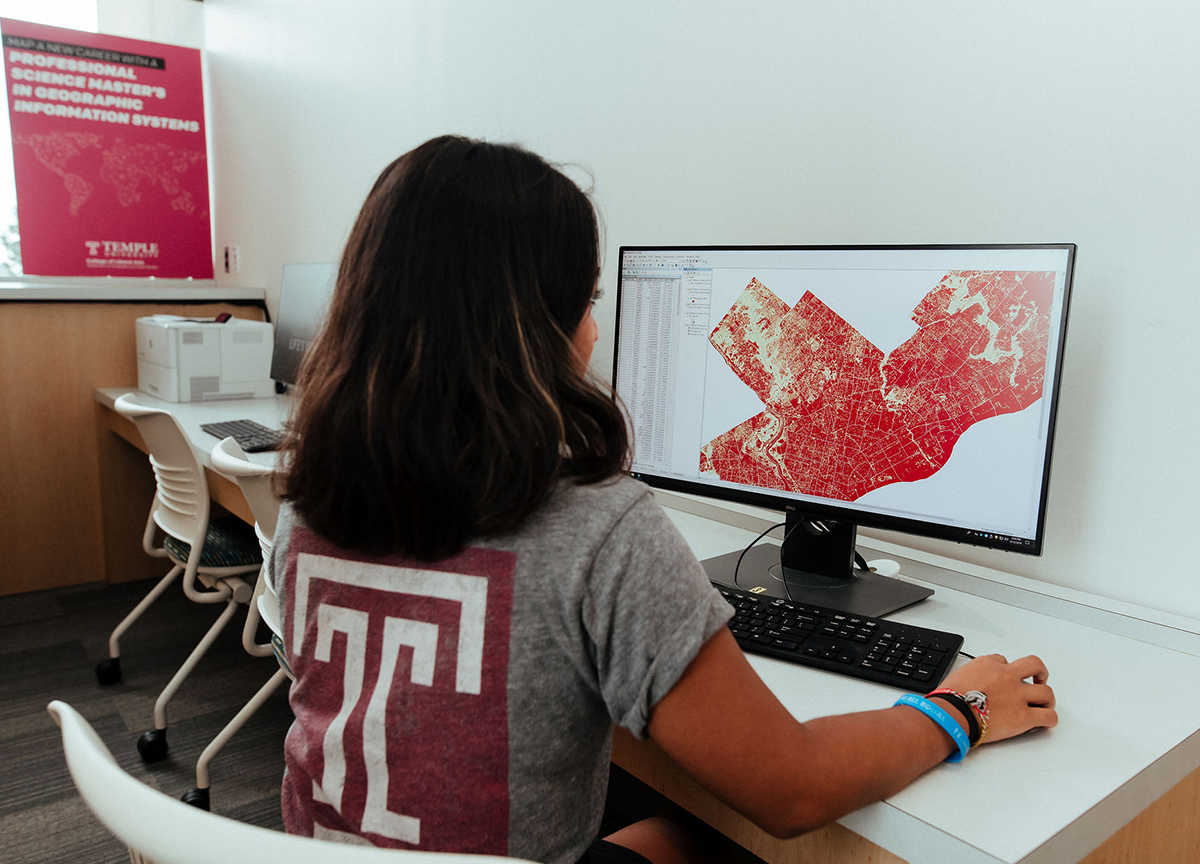Joshua Sonntag graduated from Temple University’s Professional Science Master’s in Geographic Information Systems (PSM in GIS) program on May 20, 2017. Days later, he started working as a big data engineer at Comcast — his dream company.
Similarly, Janine Simmons, who graduated with a PSM in GIS from Temple, had a full-time gig lined up on her graduation day in 2018. Simmons worked as a policy analyst at the Reinvestment Fund — which provides data-driven resources to nonprofits, government entities and philanthropic organizations. That was up until this month, when she started at Independence Blue Cross as a research analyst.
“When I came into the program, I thought ‘OK, I’ll make a couple of maps, then I’ll go home and find a job working for the federal government,’” said Simmons, who received a bachelor’s degree in political science and global security from Temple in 2017. “But this program single-handedly shifted my career outlook and what it is that I wanted to do with my life.”
Temple, on the forefront of geospatial education, began offering the PSM in GIS degree in 2015. Upon completion of the one-year graduate track, 96% of alumni secured jobs in the GIS or data science field, according to Liz Janczewski, the program’s student services coordinator. (That’s per graduates’ self-reported data verified by the university this month.)
Temple also recently launched the first PSM in Geospatial Data Science (PSM in GDS) program in response to the “explosion of data science seen over the last 15 years,” said Lee Hachadoorian, the assistant director of the PSM in GIS and GDS programs and professor of several courses.
Students who enroll in either programs have varying levels of experience with programming and GIS, he added. In addition to an ethics course and professional development opportunities, Temple’s PSM in GIS program offers advanced technical training in GIS. Geographic information systems is a method of integrating information based on location data for mapping and analytical purposes.
“If you like a challenge, and you like a niche, and you like being part of a very supportive community, the GIS program at Temple is a very good choice,” Sonntag said.
How is the PSM in GIS program structured?
Hachadoorian said the PSM in GIS program’s curriculum offers technical and topical courses. The technical courses acclimate students with GIS software, how to organize spatial data, a variety of statistical techniques, and the link between cartography and visualization.
The PSM in GIS program’s topical courses teach students how geospatial techniques apply to specific subject areas, such as urban planning, public health, political mapping and environmental issues. The program’s faculty have a number of different specialties that allow the course offerings to cover a wide range of topics.
“The thing that’s really exciting about GIS is just how broadly applicable it is,” Hachadoorian said. “You probably have something in your life that excites you, and I can find some way to find spatial data for you to be able to dig into that passion in a way you haven’t thought about before.”
GIS is an evolving field, and the program has proven itself able to adapt to necessary changes.
After launching in 2015, the program changed some of its course offerings to account for students with different levels of programming experience. Now, PSM in GIS students take a required introductory programming course, and those who want to further develop their programming skills take the advanced application development course that’s required for the PSM in GDS program.
“We think the PSM in GDS program is going to be really valuable for students that want to go in the direction of machine learning and big geospatial data and data science type positions,” Hachadoorian said. “They’ll be very well positioned for sort of the traditional data science tasks, as well as having a strong understanding of the nature of spatial data and spatial data handling.”
And because of Temple’s affiliation with the National Professional Science Master’s Association, both geospatial master’s programs have a required course in ethics and professional practice. Hachadoorian said this course is essential because the arenas that GIS is typically used for impact people’s lives in crucial ways. The program trains students to catch ethical red flags in their work.
“As analysts, we need to be aware of that and how our choices are going to strongly affect people’s experiences,” he added.
The positive impact for alumni
Hachadoorian said it’s thrilling to see students’ success after they’ve graduated from the program. He expects the skills that students learn in Temple’s geospatial master’s programs to benefit them for years to come.
Both programs provide an academic route toward real-world, professional advantages. As a programming and GIS rookie starting the program, Simmons said her lifelong interest in social science was quickly piqued when she saw the capabilities of GIS. After graduating, she was able to apply her passion for matters of public good at the Reinvestment Fund, supporting nonprofits and philanthropic organizations with the skills she acquired at Temple.
The structure of the PSM in GIS program allowed for professional development in the field, Simmons said. The graduate track solely offers night classes, so students can spend their days working on professional activities, such as full-time jobs or internships.
During her final semester in the program, Simmons was a GIS intern at the Reinvestment Fund. Before even graduating, Simmons was working there full-time and used one of her work projects as her graduate thesis.
“Professional development is built into the program,” she added. “It’s definitely geared toward the idea that you’re going to graduate with this degree and they’re going to assist you with getting into some form of a data analytics profession.” Sonntag, similarly, balanced professional and academic responsibilities while studying for the PSM in GIS degree. He was a full-time employee at the defense contractor BAE Systems before graduating and moving to Comcast.
Sonntag also used the PSM in GIS program as a professional leverage point, since his job encouraged him to pursue the advanced degree so he could move up in the company.
“I jumped at the opportunity,” Sonntag said. “The program quite literally expanded my career, and I immediately got my job at Comcast. I went from a stepping stone to working for the peak of Philadelphia at Comcast.”
Learn more about the PSM in GIS program
This article is sponsored by Temple University and was reviewed before publication.
Before you go...
Please consider supporting Technical.ly to keep our independent journalism strong. Unlike most business-focused media outlets, we don’t have a paywall. Instead, we count on your personal and organizational support.
Join our growing Slack community
Join 5,000 tech professionals and entrepreneurs in our community Slack today!

20 entrepreneurship, tech and startup events to fill your February

These simple but crucial policy updates could be game-changers for entrepreneurs with disabilities

Comcast isn’t worried about free Super Bowl streaming — here’s why


